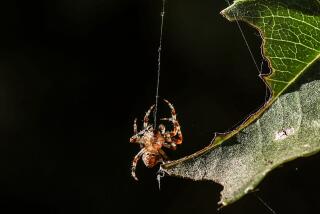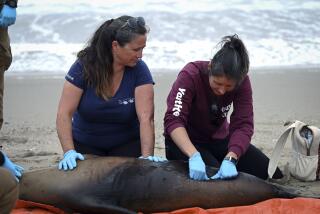Reports of Snake Sightings Rise With Temperature in Southland
Slithering toward the sunshine, snakes have made early appearances in the Southland this year, prompting a rash of calls to animal control centers.
Snake sightings always increase with the arrival of spring, when the creatures emerge from their underground homes to seek the warm sun. But snake monitors said unusually warm weather has drawn out the creatures earlier than normal.
On one recent day, Laguna Beach Animal Control Officer Joy Lingenfelter received five calls about snakes; generally, she gets only four to 10 calls a week, even in the summer.
Of the five snakes, three were rattlesnakes, the only poisonous kind in the area, and the others were a gopher snake and a striped racer.
Local biologist Elisabeth Brown, who leads hikes in Laguna Canyon, said her tour group saw rattlesnakes on two consecutive days recently. Before that, she hadn’t seen a rattler in several years.
“It was unusual for me to have been close to two in a row like that,” Brown said.
That experience is being repeated around Southern California, authorities say.
The San Diego division of the California Poison Control System, which assists emergency room doctors in seven Southern California counties, has received 10 reports of snakebites this season, up from the usual three or four this time of year, toxicologist Anthony Manoguerra said.
The early warm weather has also coaxed from seclusion a virtual army of other critters, including rodents, lizards, scorpions, spiders and mosquitoes, said Richard Meyer, assistant manager of the Orange County Vector Control District. “A lot of these things are also trying to get into houses,” he said. “We’ve been getting a lot of calls on spiders.”
Like snakes, these creatures generally appear in the spring. This year’s sightings began four to six weeks earlier than normal, he said.
In the Southland, snakes are generally found on hillsides, in brush-covered areas and around homes that abut canyons and wilderness areas. They are most active in the morning and evening.
Most snakes are “good neighbors,” said Orange County Animal Control Officer Marie Hulett.
Sometimes it’s hard to predict where a snake may lurk. Given the opportunity, Lingenfelter said, snakes will even slink through an open door to cool off indoors.
“All day they go from hot to cold spots in an attempt to regulate their body temperature,” she said. She recalled a man who called to report a hefty rattlesnake cooling itself on his elderly mother’s tile kitchen floor. The woman, who was nearly blind, had been walking between two counters as she made lunch, each time passing the coiled snake.
“That could have been real bad,” Lingenfelter said.
Rattlesnakes may announce their presence by shaking the rattle at the tip of their tails, which is actually loosely attached scale segments that make noise when they strike each other. At the sight or sound of a rattler, a hiker should freeze, to give the snake a chance to slither away.
“You’d be surprised how many people get bitten when they want to do something with the snake,” Manoguerra said.
“They want to pick it up, show it to their friends, keep it as a pet. It’s not just children, it’s usually adults.”
If bitten, the victim should loosen tight clothing and calmly seek help. Running quickens the heart and pushes the venom through the system.
If the journey is too stressful--if it’s uphill, for example--the victim’s hiking buddy should go quickly for help, Manoguerra said.
“Most people think they have minutes,” he said. “They really have hours” before a bite poses serious harm.
“It’s pretty unusual for someone to die of a rattlesnake bite,” Manoguerra said, “unless they get no care at all.”
More to Read
Sign up for Essential California
The most important California stories and recommendations in your inbox every morning.
You may occasionally receive promotional content from the Los Angeles Times.










